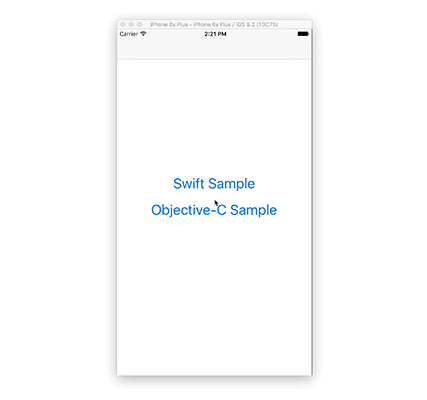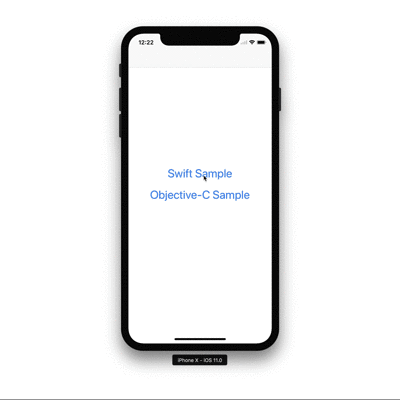marty-suzuki / Misterfusion
Programming Languages
Projects that are alternatives of or similar to Misterfusion
MisterFusion
MisterFusion makes more easier to use AutoLayout in Swift & Objective-C code.
Features
- [x] Simple And Concise Syntax
- [x] Use in Swift and Objective-C
- [x] Support Size Class
- [x] Support Swift5
- [x] Support Swift4 (until 4.0.1)
- [x] Support SafeArea🎉 (Swift3.2 since 2.3.1, Swift4 since 3.1.0)
- [x] Support iOS
- [x] Support tvOS (since 3.2.0)
- [x] Support macOS (since 4.0.0)
MisterFusion Code for Swift
let view = UIView()
self.view.mf.addSubview(view, andConstraints:
view.top |+| 10,
view.right |-| 10,
view.left |+| 10,
view.bottom |-| 10
)
Ordinary Code for Swift
This is same implementation as above code, but this is hard to see.
let view = UIView()
self.view.addSubview(view)
view.translatesAutoresizingMaskIntoConstraints = false
self.view.addConstraints([
NSLayoutConstraint(item: view, attribute: .top, relatedBy: .equal, toItem: self.view, attribute: .top, multiplier: 1, constant: 10),
NSLayoutConstraint(item: view, attribute: .right, relatedBy: .equal, toItem: self.view, attribute: .right, multiplier: 1, constant: -10),
NSLayoutConstraint(item: view, attribute: .left, relatedBy: .equal, toItem: self.view, attribute: .left, multiplier: 1, constant: 10),
NSLayoutConstraint(item: view, attribute: .bottom, relatedBy: .equal, toItem: self.view, attribute: .bottom, multiplier: 1, constant: -10),
])
MisterFusion Code for Objective-C
UIView *view = [UIView new];
[self.view addLayoutSubview:view andConstraints:@[
view.Top .Constant(10.0f),
view.Right .Constant(-10.0f),
view.Left .Constant(10.0f),
view.Bottom.Constant(-10.0f)
]];
Ordinary Code for Objective-C
This is same implementation as above code, but this is hard to see.
UIView *view = [UIView new];
view.translatesAutoresizingMaskIntoConstraints = NO;
[self.view addSubview: view];
[self.view addConstraints:@[
[NSLayoutConstraint constraintWithItem:view attribute:NSLayoutAttributeTop relatedBy:NSLayoutRelationEqual toItem:self.view attribute:NSLayoutAttributeTop multiplier:1.0f constant:10.0f],
[NSLayoutConstraint constraintWithItem:view attribute:NSLayoutAttributeRight relatedBy:NSLayoutRelationEqual toItem:self.view attribute:NSLayoutAttributeRight multiplier:1.0f constant:-10.0f],
[NSLayoutConstraint constraintWithItem:view attribute:NSLayoutAttributeLeft relatedBy:NSLayoutRelationEqual toItem:self.view attribute:NSLayoutAttributeLeft multiplier:1.0f constant:10.0f],
[NSLayoutConstraint constraintWithItem:view attribute:NSLayoutAttributeHeight relatedBy:NSLayoutRelationEqual toItem:self.view attribute:NSLayoutAttributeHeight multiplier:0.5f constant:-15.0f]
]];
Sample Layout
If you want to realize layout like a above image, needed code is only this.
let redView = UIView()
redView.backgroundColor = .red
self.view.mf.addSubview(redView, andConstraints:
redView.top |+| 10,
redView.right |-| 10,
redView.left |+| 10
)
let yellowView = UIView()
yellowView.backgroundColor = .yellow
self.view.mf.addSubview(yellowView, andConstraints:
yellowView.top |==| redView.bottom |+| 10,
yellowView.left |+| 10,
yellowView.bottom |-| 10,
yellowView.height |==| redView.height
)
let greenView = UIView()
greenView.backgroundColor = .green
self.view.mf.addSubview(greenView, andConstraints:
greenView.top |==| redView.bottom |+| 10,
greenView.left |==| yellowView.right |+| 10,
greenView.bottom |-| 10,
greenView.right |-| 10,
greenView.width |==| yellowView.width,
greenView.height |==| yellowView.height
)
Installation
CocoaPods
MisterFusion is available through CocoaPods. If you have cocoapods 0.39.0 or greater, you can install it, simply add the following line to your Podfile:
pod 'MisterFusion'
In addtion, import MisterFusion like this.
Swift
import MisterFusion
Objective-C
#import <MisterFusion/MisterFusion-Swift.h>
Carthage
If you’re using Carthage, simply add
MisterFusion to your Cartfile:
github "szk-atmosphere/MisterFusion"
Make sure to add MisterFusion.framework to "Linked Frameworks and Libraries" and "copy-frameworks" Build Phases.
Advanced Setting
You can set multiplier, constant and priority like this.
(This is same implementation as first example.)
Swift
self.view.mf.addSubview(view, andConstraints:
view.top |==| self.view.top |*| 1 |+| 10 |<>| UILayoutPriorityRequired,
view.right |==| self.view.right |*| 1 |-| 10 |<>| UILayoutPriorityRequired,
view.left |==| self.view.left |*| 1 |+| 10 |<>| UILayoutPriorityRequired,
view.bottom |==| self.view.bottom |*| 1 |-| 10 |<>| UILayoutPriorityRequired
)
Objective-C
[self.view addLayoutSubview:view andConstraints:@[
view.Top .Equal(self.view.Top) .Multiplier(1.0f).Constant(10.0f) .Priority(UILayoutPriorityRequired),
view.Right .Equal(self.view.Right) .Multiplier(1.0f).Constant(-10.0f).Priority(UILayoutPriorityRequired),
view.Left .Equal(self.view.Left) .Multiplier(1.0f).Constant(10.0f) .Priority(UILayoutPriorityRequired),
view.Bottom.Equal(self.view.Bottom).Multiplier(1.0f).Constant(-10.0f).Priority(UILayoutPriorityRequired)
]];
For Swift
Operators
-
|==|,|<=|,|>=|...NSLayoutRelationand fixedheightandwidth -
|*|,|/|...multiplier -
|+|,|-|...constant -
|<>|...UILayoutPriority -
<|>...UIUserInterfaceSizeClassfor VerticalSizeClass -
<->...UIUserInterfaceSizeClassfor HorizontalSizeClass -
-=-... Identifier
UIView Extensions
public func addLayoutConstraint(_ misterFusion: MisterFusion) -> NSLayoutConstraint?
public func addLayoutConstraints(_ misterFusions: MisterFusion...) -> [NSLayoutConstraint]
public func addLayoutConstraints(_ misterFusions: [MisterFusion]) -> [NSLayoutConstraint]
public func addLayoutSubview(_ subview: UIView, andConstraint misterFusion: MisterFusion) -> NSLayoutConstraint?
public func addLayoutSubview(_ subview: UIView, andConstraints misterFusions: [MisterFusion]) -> [NSLayoutConstraint]
public func addLayoutSubview(_ subview: UIView, andConstraints misterFusions: MisterFusion...) -> [NSLayoutConstraint]
public func insertLayoutSubview(_ subview: UIView, at index: Int, andConstraint misterFusion: MisterFusion) -> NSLayoutConstraint?
public func insertLayoutSubview(_ subview: UIView, at index: Int, andConstraints misterFusions: [MisterFusion]) -> [NSLayoutConstraint]
public func insertLayoutSubview(_ subview: UIView, at index: Int, andConstraints misterFusions: MisterFusion...) -> [NSLayoutConstraint]
public func insertLayoutSubview(_ subview: UIView, belowSubview siblingSubview: UIView, andConstraint misterFusion: MisterFusion) -> NSLayoutConstraint?
public func insertLayoutSubview(_ subview: UIView, belowSubview siblingSubview: UIView, andConstraints misterFusions: [MisterFusion]) -> [NSLayoutConstraint]
public func insertLayoutSubview(_ subview: UIView, belowSubview siblingSubview: UIView, andConstraints misterFusions: MisterFusion...) -> [NSLayoutConstraint]
public func insertLayoutSubview(_ subview: UIView, aboveSubview siblingSubview: UIView, andConstraint misterFusion: MisterFusion) -> NSLayoutConstraint?
public func insertLayoutSubview(_ subview: UIView, aboveSubview siblingSubview: UIView, andConstraints misterFusions: [MisterFusion]) -> [NSLayoutConstraint]
public func insertLayoutSubview(_ subview: UIView, aboveSubview siblingSubview: UIView, andConstraints misterFusions: MisterFusion...) -> [NSLayoutConstraint]
Array Extensions
public func firstItem(_ view: UIView) -> [NSLayoutConstraint]
public func firstAttribute(_ attribute: NSLayoutAttribute) -> [NSLayoutConstraint]
public func relation(_ relation: NSLayoutRelation) -> [NSLayoutConstraint]
public func secondItem(_ view: UIView) -> [NSLayoutConstraint]
public func secondAttribute(_ attribute: NSLayoutAttribute) -> [NSLayoutConstraint]
You can get added NSLayoutConstraint with those functions.
This is a example.
let bottomConstraint: NSLayoutConstraint = self.view.addLayoutSubview(view, andConstraints:
view.top |+| 10,
view.right |-| 10,
view.left |+| 10,
view.bottom |-| 10
).firstAttribute(.bottom).first
You can use Size Class with func traitCollectionDidChange(previousTraitCollection: UITraitCollection?).
This is an example Regular, Compact size for iPhone6s+.
override func traitCollectionDidChange(previousTraitCollection: UITraitCollection?) {
guard let whiteView = whiteView, redView = redView else { return }
if let whiteViewHeightConstraint = whiteViewWidthConstraint {
redView.removeConstraint(whiteViewHeightConstraint)
}
self.whiteViewWidthConstraint = redView.mf.addConstraints(
whiteView.width |-| 20 <|> .compact <-> .regular,
whiteView.width |*| 0.5 |-| 10 <|> .regular <-> .compact
).firstAttribute(.width).first
}
- A detail sample is here
Safe Area
You can use view.safeArea.top and so on. This is supported Safe Area.
view.mf.addConstraints(
yellowView.top |==| redView.bottom |+| 10,
yellowView.right |==| view.safeArea.right |-| 10,
yellowView.left |==| view.safeArea.left |+| 10,
yellowView.height |==| view.safeArea.height |/| 2 |-| 15
)
If OS version is below iOS 11, view.safeArea.top returns view.top internally.
Those are accessible safeArea properties.
extension UIView {
public var safeArea: UIViewSafeArea { get }
}
extension UIViewSafeArea {
public var top: MisterFusion { get }
public var right: MisterFusion { get }
public var left: MisterFusion { get }
public var bottom: MisterFusion { get }
public var height: MisterFusion { get }
public var width: MisterFusion { get }
public var leading: MisterFusion { get }
public var trailing: MisterFusion { get }
public var centerX: MisterFusion { get }
public var centerY: MisterFusion { get }
public var notAnAttribute: MisterFusion { get }
public var lastBaseline: MisterFusion { get }
public var firstBaseline: MisterFusion { get }
public var leftMargin: MisterFusion { get }
public var rightMargin: MisterFusion { get }
public var topMargin: MisterFusion { get }
public var bottomMargin: MisterFusion { get }
public var leadingMargin: MisterFusion { get }
public var trailingMargin: MisterFusion { get }
public var centerXWithinMargins: MisterFusion { get }
public var centerYWithinMargins: MisterFusion { get }
}
In ViewController, you can use self.safeArea.top and self.safeArea.bottom.
Greater than or equal to iOS 11, self.safeArea.top returns self.view.safeAreaLayoutGuide.topAnchor.
And self.safeArea.bottom returns, self.view.safeAreaLayoutGuide.bottomAnchor.
Less then or equal to iOS 10, self.safeArea.top returns 'self.topLayoutGuide.bottomAnchor'.
And self.safeArea.bottom returns, self.bottomLayoutGuide.topAnchor.
extension UIViewController {
public var safeArea: UIViewControllerSafeArea { get }
}
extension UIViewControllerSafeArea {
public var top: MisterFusion { get }
public var bottom: MisterFusion { get }
}
For Objective-C
Readonly Blocks
@interface MisterFusion : NSObject
//NSLayoutRelation
@property (nonatomic, readonly, copy) MisterFusion * __nullable (^ __nonnull Equal)(MisterFusion * __nonnull);
@property (nonatomic, readonly, copy) MisterFusion * __nullable (^ __nonnull LessThanOrEqual)(MisterFusion * __nonnull);
@property (nonatomic, readonly, copy) MisterFusion * __nullable (^ __nonnull GreaterThanOrEqual)(MisterFusion * __nonnull);
//multiplier
@property (nonatomic, readonly, copy) MisterFusion * __nullable (^ __nonnull Multiplier)(CGFloat);
//constant
@property (nonatomic, readonly, copy) MisterFusion * __nullable (^ __nonnull Constant)(CGFloat);
@property (nonatomic, readonly, copy) MisterFusion * __nullable (^ __nonnull NotRelatedEqualConstant)(CGFloat);
@property (nonatomic, readonly, copy) MisterFusion * __nullable (^ __nonnull NotRelatedLessThanOrEqualConstant)(CGFloat);
@property (nonatomic, readonly, copy) MisterFusion * __nullable (^ __nonnull NotRelatedGreaterThanOrEqualConstant)(CGFloat);
//@property (nonatomic, readonly, copy) MisterFusion * __nullable (^ __nonnull NotRelatedConstant)(CGFloat); (deprecated since 1.1.0, use NotRelatedEqualConstant)
//UILayoutPriority
@property (nonatomic, readonly, copy) MisterFusion * __nullable (^ __nonnull Priority)(UILayoutPriority);
//UIUserInterfaceSizeClass for HorizontalSizeClass
@property (nonatomic, readonly, copy) MisterFusion * __nullable (^ __nonnull HorizontalSizeClass)(UIUserInterfaceSizeClass);
//UIUserInterfaceSizeClass for VerticalSizeClass
@property (nonatomic, readonly, copy) MisterFusion * __nullable (^ __nonnull VerticalSizeClass)(UIUserInterfaceSizeClass);
//Identifier
@property (nonatomic, readonly, copy) MisterFusion * _Nullable (^ _Nonnull Identifier)(NSString * _Nonnull);
@end
UIView Category
- (NSLayoutConstraint * _Nullable)addLayoutConstraint:(MisterFusion * _Nonnull)misterFusion;
- (NSArray<NSLayoutConstraint *> * _Nonnull)addLayoutConstraints:(NSArray<MisterFusion *> * _Nonnull)misterFusions;
- (NSLayoutConstraint * _Nullable)addLayoutSubview:(UIView * _Nonnull)subview andConstraint:(MisterFusion * _Nonnull)misterFusion;
- (NSArray<NSLayoutConstraint *> * _Nonnull)addLayoutSubview:(UIView * _Nonnull)subview andConstraints:(NSArray<MisterFusion *> * _Nonnull)misterFusions;
- (NSLayoutConstraint * _Nullable)insertLayoutSubview:(UIView * _Nonnull)subview atIndex:(NSInteger)index andConstraint:(MisterFusion * _Nonnull)misterFusion;
- (NSArray<NSLayoutConstraint *> * _Nonnull)insertLayoutSubview:(UIView * _Nonnull)subview atIndex:(NSInteger)index andConstraints:(NSArray<MisterFusion *> * _Nonnull)misterFusions;
- (NSLayoutConstraint * _Nullable)insertLayoutSubview:(UIView * _Nonnull)subview belowSubview:(UIView * _Nonnull)siblingSubview andConstraint:(MisterFusion * _Nonnull)misterFusion;
- (NSArray<NSLayoutConstraint *> * _Nonnull)insertLayoutSubview:(UIView * _Nonnull)subview belowSubview:(UIView * _Nonnull)siblingSubview andConstraints:(NSArray<MisterFusion *> * _Nonnull)misterFusions;
- (NSLayoutConstraint * _Nullable)insertLayoutSubview:(UIView * _Nonnull)subview aboveSubview:(UIView * _Nonnull)siblingSubview andConstraint:(MisterFusion * _Nonnull)misterFusion;
- (NSArray<NSLayoutConstraint *> * _Nonnull)insertLayoutSubview:(UIView * _Nonnull)subview aboveSubview:(UIView * _Nonnull)siblingSubview andConstraints:(NSArray<MisterFusion *> * _Nonnull)misterFusions;
NSArray Category
@property (nonatomic, readonly, copy) NSArray * __nonnull (^ __nonnull FirstItem)(UIView * __nonnull);
@property (nonatomic, readonly, copy) NSArray * __nonnull (^ __nonnull FirstAttribute)(NSLayoutAttribute);
@property (nonatomic, readonly, copy) NSArray * __nonnull (^ __nonnull SecondItem)(UIView * __nonnull);
@property (nonatomic, readonly, copy) NSArray * __nonnull (^ __nonnull SecondAttribute)(NSLayoutAttribute);
@property (nonatomic, readonly, copy) NSArray * __nonnull (^ __nonnull Reration)(NSLayoutRelation);
You can get added NSLayoutConstraint with those properties.
This is a example.
NSLayoutConstraint *bottomConstraint = [self.view addLayoutSubview:view andConstraints:@[
view.Top .Constant(10.0f),
view.Right .Constant(-10.0f),
view.Left .Constant(10.0f),
view.Bottom.Constant(-10.0f)
]].FirstAttribute(NSLayoutAttributeBottom).firstObject;
You can use Size Class with - (void)traitCollectionDidChange:(UITraitCollection *)previousTraitCollection.
This is an example Regular, Compact size for iPhone6s+.
- (void)traitCollectionDidChange:(UITraitCollection *)previousTraitCollection {
[self.redView removeConstraint:self.whiteViewWidthConstraint];
self.whiteViewWidthConstraint = [self.redView addLayoutConstraints:@[
self.whiteView.Width.Multiplier(0.5f).Constant(-10).VerticalSizeClass(UIUserInterfaceSizeClassRegular).HorizontalSizeClass(UIUserInterfaceSizeClassCompact),
self.whiteView.Width.Constant(-20).VerticalSizeClass(UIUserInterfaceSizeClassCompact).HorizontalSizeClass(UIUserInterfaceSizeClassRegular)
]].FirstAttribute(NSLayoutAttributeWidth).firstObject;
}
- A detail sample is here
Safe Area
You can use self.view.SafeAreaTop and so on. This is supported Safe Area.
[self.view addLayoutConstraints:@[
yellowView.Top .Equal(redView.Bottom) .Constant(10.0f),
yellowView.Right .Equal(self.view.SafeAreaRight) .Constant(-10.0f),
yellowView.Left .Equal(self.view.SafeAreaLeft) .Constant(10.0f),
yellowView.Height.Equal(self.view.SafeAreaHeight).Multiplier(0.5f).Constant(-15.0f)
]];
If OS version is below iOS 11, self.view.SafeAreaTop returns self.view.Top internally.
Those are accessible safeArea properties.
// UIView
@property (nonatomic, readonly, strong) MisterFusion * _Nonnull SafeAreaTop;
@property (nonatomic, readonly, strong) MisterFusion * _Nonnull SafeAreaRight;
@property (nonatomic, readonly, strong) MisterFusion * _Nonnull SafeAreaLeft;
@property (nonatomic, readonly, strong) MisterFusion * _Nonnull SafeAreaBottom;
@property (nonatomic, readonly, strong) MisterFusion * _Nonnull SafeAreaHeight;
@property (nonatomic, readonly, strong) MisterFusion * _Nonnull SafeAreaWidth;
@property (nonatomic, readonly, strong) MisterFusion * _Nonnull SafeAreaLeading;
@property (nonatomic, readonly, strong) MisterFusion * _Nonnull SafeAreaTrailing;
@property (nonatomic, readonly, strong) MisterFusion * _Nonnull SafeAreaCenterX;
@property (nonatomic, readonly, strong) MisterFusion * _Nonnull SafeAreaCenterY;
@property (nonatomic, readonly, strong) MisterFusion * _Nonnull SafeAreaNotAnAttribute;
@property (nonatomic, readonly, strong) MisterFusion * _Nonnull SafeAreaLastBaseline;
@property (nonatomic, readonly, strong) MisterFusion * _Nonnull SafeAreaFirstBaseline;
@property (nonatomic, readonly, strong) MisterFusion * _Nonnull SafeAreaLeftMargin;
@property (nonatomic, readonly, strong) MisterFusion * _Nonnull SafeAreaRightMargin;
@property (nonatomic, readonly, strong) MisterFusion * _Nonnull SafeAreaTopMargin;
@property (nonatomic, readonly, strong) MisterFusion * _Nonnull SafeAreaBottomMargin;
@property (nonatomic, readonly, strong) MisterFusion * _Nonnull SafeAreaLeadingMargin;
@property (nonatomic, readonly, strong) MisterFusion * _Nonnull SafeAreaTrailingMargin;
@property (nonatomic, readonly, strong) MisterFusion * _Nonnull SafeAreaCenterXWithinMargins;
@property (nonatomic, readonly, strong) MisterFusion * _Nonnull SafeAreaCenterYWithinMargins;
In ViewController, you can use self.SafeAreaTop and self.SafeAreaBottom.
Greater than or equal to iOS 11, self.SafeAreaTop returns self.view.safeAreaLayoutGuide.topAnchor.
And self.SafeAreaBottom returns, self.view.safeAreaLayoutGuide.bottomAnchor.
Less then or equal to iOS 10, self.SafeAreaTop returns 'self.topLayoutGuide.bottomAnchor'.
And self.SafeAreaBottom returns, self.bottomLayoutGuide.topAnchor.
// UIViewController
@property (nonatomic, readonly, strong) MisterFusion * _Nonnull SafeAreaTop;
@property (nonatomic, readonly, strong) MisterFusion * _Nonnull SafeAreaBottom;
Requirements
- Xcode 10.2 or greater
- iOS 8.0 or greater
- tvOS 10.0 or greater
- macOS 10.11 or greater
Author
Taiki Suzuki, [email protected]
License
MisterFusion is available under the MIT license. See the LICENSE file for more info.









